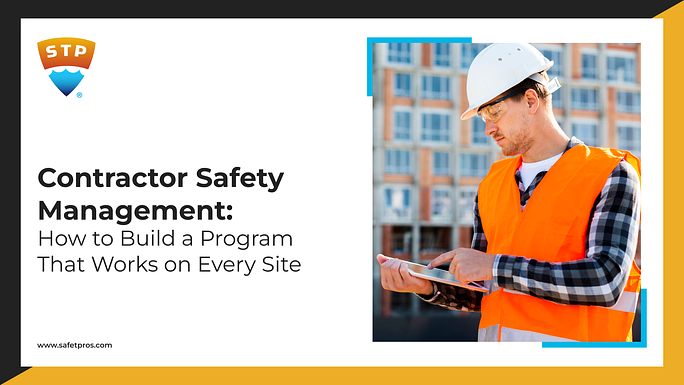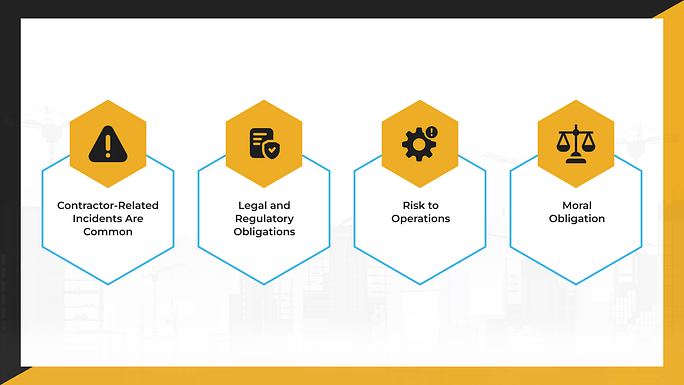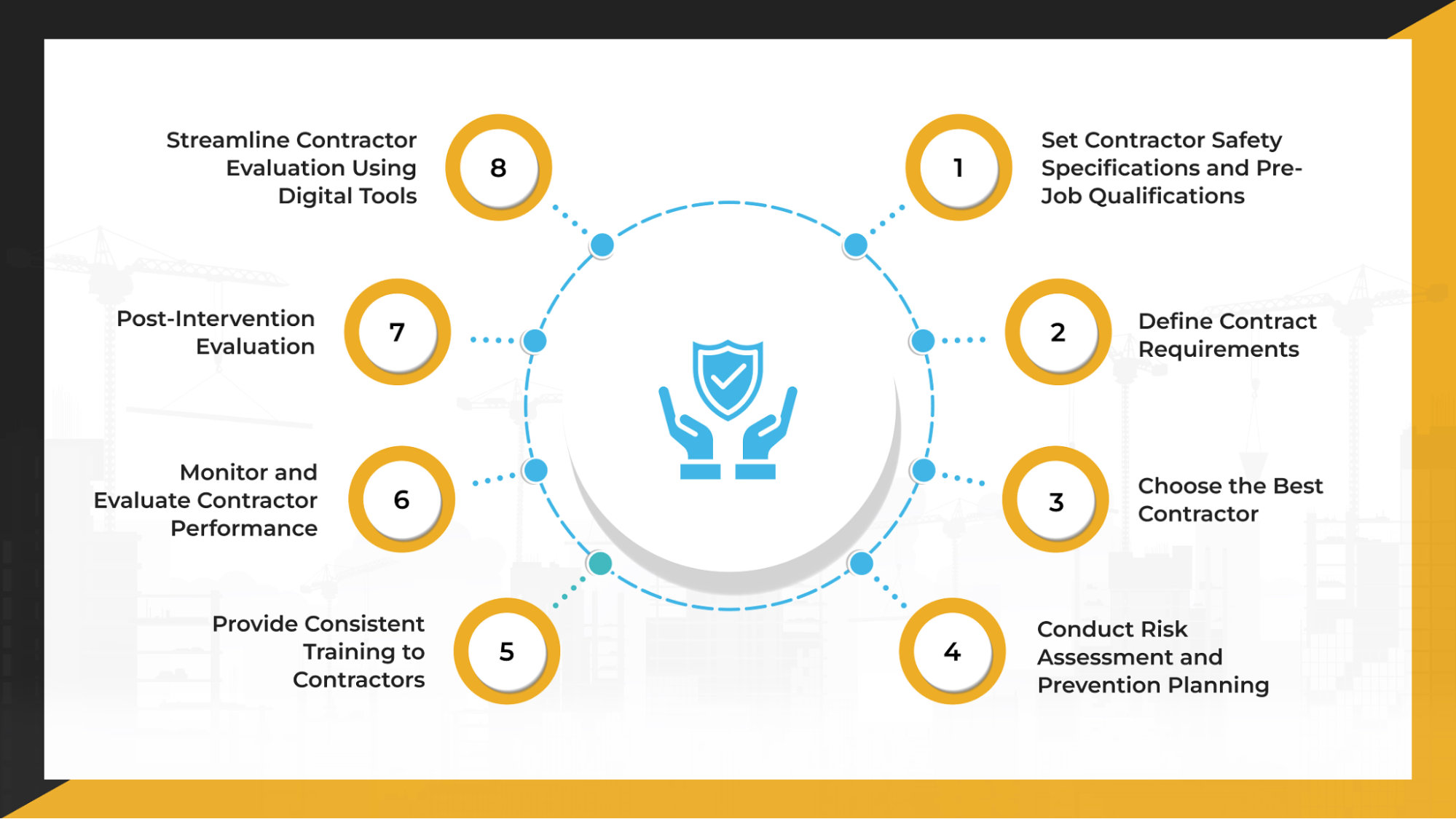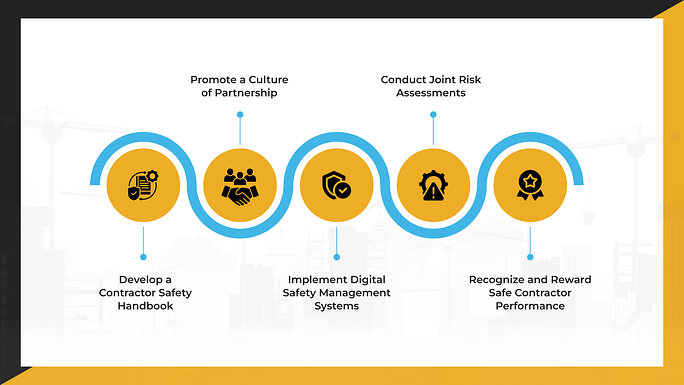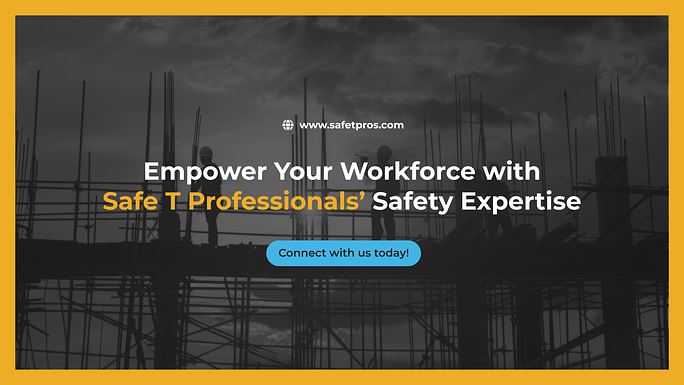For every safety leader and project manager, one concern keeps coming back: “Are we doing enough to keep our contractors safe?”
Despite having safety rules, incidents still happen. Contractors often account for a large share of workplace injuries and fatalities, many of which could have been avoided with better planning, clearer communication, and stronger oversight.
The challenge is real. Contractors may come from different safety cultures, follow varying standards, or manage multiple clients simultaneously. Without a structured approach, gaps can easily appear, leading to serious harm, legal issues, or costly delays.
Contractor safety management is not just a box to check. It is a crucial part of maintaining safety, ensuring smooth operations, and protecting your company’s reputation. Whether you manage a single site or multiple locations, having a clear, effective contractor safety program can help you reduce risks and meet both legal and ethical responsibilities.
In this blog, we’ll break down what contractor safety management is, why it matters, and how you can build a program that works.
The Essentials of Contractor Safety Management: What Every Company Should Know
Contractor safety management (CSM) is a structured process that ensures contractors working for a company adhere to all required safety standards and practices. It protects workers, prevents incidents, and ensures compliance with legal and organizational safety requirements.
Essential Aspects of Improving Contractor Safety Management
1. Systematic Process
Contractor safety management is not a one-time activity. It includes the pre-qualification of contractors based on their safety records, training, and induction to ensure that contractors understand site-specific risks. Additionally, it involves monitoring and supervision to verify that safety rules are followed during the work, as well as incident reporting and review to identify causes and prevent recurrence.
2. Dual Responsibility
Contractors’ responsibility
Contractors are responsible for protecting the safety and health of their employees. They must provide their workers with proper training, safety equipment, and adequate supervision.
The company’s responsibility
The hiring organization must ensure that contractors comply with the company’s safety policies, follow site-specific safety requirements, and meet all applicable legal and regulatory obligations. This shared responsibility ensures that all workers on a site are kept safe, regardless of who employs them.
3. Relevant Standards and Regulations
Contractor safety management is guided by several national laws and international standards that establish safety expectations and legal obligations.
In the United States, the Occupational Safety and Health Administration (OSHA) establishes and enforces workplace safety regulations to safeguard workers across various industries. Internationally, ISO 45001 serves as the global standard for Occupational Health and Safety Management Systems (OHSMS), helping organizations create structured and safe working environments.
Before the introduction of ISO 45001, OHSAS 18001 was widely recognized as a standard for occupational health and safety management, although it has now largely been superseded by it. In Australia, the Work Health and Safety (WHS) Act provides a legal framework to ensure the health, safety, and welfare of all workers.
Each of these standards emphasizes the need for both contractors and hiring companies to work together to achieve safe operations.
Why Contractor Safety Management Is Essential for Workplace Safety and Compliance
Contractor safety management is crucial because it helps prevent injuries, ensures compliance with laws, protects business operations, and upholds ethical responsibilities. Below are the essential reasons why CSM is necessary.
1. Contractor-Related Incidents Are Common
Contractors often face higher risks because they may work in unfamiliar environments or handle high-risk tasks. Data from the U.S. Bureau of Labor Statistics (BLS) indicate that contractors account for approximately 15% to 20% of all workplace fatalities in sectors such as construction and industrial operations.
In some large projects, contractor workers have been found to represent over 30% of total injuries reported on-site. These numbers underscore the importance of robust safety management to safeguard all workers, regardless of their employer.
2. Legal and Regulatory Obligations
Companies are legally required to ensure that contractors follow safety standards. Regulations like OSHA (USA), ISO 45001, and other national laws hold organizations responsible for the safety of all workers on their sites, including contractors.
Failure to manage contractor safety can result in fines, legal action, and shutdowns. For example, OSHA penalties for serious violations can exceed $16,000 per violation, and companies can be held liable for incidents involving contractors if negligence in oversight is proven.
3. Risk to Operations
Poor contractor safety can significantly disrupt operations. A serious incident may stop work, trigger investigations, and delay project timelines.
In large industrial projects, safety-related shutdowns can result in significant financial losses for companies, including millions of dollars in lost productivity and penalties. Additionally, incidents can damage a company’s reputation with clients, regulators, and the public, making it more difficult to secure future contracts.
4. Moral Obligation
Beyond legal and financial reasons, organizations have a moral duty to protect everyone who works on their sites. This includes ensuring that contractors work under safe conditions, have proper training, and have access to necessary safety equipment.
A strong contractor safety program shows that a company values human life and well-being, which can also help build trust with employees, contractors, and stakeholders.
How to Implement a Contractor Safety Management Program
Implementing an effective contractor safety management program is crucial for protecting workers, ensuring compliance with safety regulations, and delivering high-quality work. Below is a detailed explanation that breaks down the essential stages of implementation.
1. Set Contractor Safety Specifications and Pre-Job Qualifications
Start by defining clear safety rules and expectations. These should be included in your bid documents so that contractors are aware of the safety requirements before submitting proposals.
Clearly state in contracts who is responsible for each safety-related duty. Avoid adding requirements that you do not intend to enforce. This prevents confusion and ensures accountability.
Develop a consistent method to assess potential contractors. This includes:
- Reviewing safety performance indicators such as the contractor’s Total Recordable Incident Rate (TRIR) and Days Away, Restricted, or Transferred (DART) rates over the past five years.
- Comparing these rates with industry averages using the contractor’s NAICS code.
- Reviewing records like workers’ compensation claims, injury logs, training certifications, equipment maintenance logs, and environmental compliance reports.
- Checking for any past OSHA citations on OSHA’s official website.
2. Define Contract Requirements
Before work begins, the contract must clearly define the scope and expectations of the task. This includes specifying the location of the work, the purpose of the activities, and the procedures and processes to be followed in alignment with the company’s quality and EHS policies.
It should identify the main person responsible for overseeing the work, outline the necessary equipment and the number of qualified personnel required, and list the essential skills, certifications, and work permits needed to perform the job safely.
The contract must also state the required personal protective equipment (PPE), ensure compliance with all relevant health and safety standards throughout the task, and confirm the expected delivery date. A well-drafted contract serves as a foundational tool for managing safety, maintaining quality, and protecting both the employer and the contractor.
3. Choose the Best Contractor
Select contractors based on safety and quality, not just price. Use an evaluation matrix that considers the contractor’s experience in similar work or industry, the strength of the contractor’s occupational health and safety policy, and the availability of the necessary equipment and qualified personnel.
The contractor selection process should include clearly defined costs that align with your budget, along with any other criteria relevant to your project’s specific needs.
Reviewing references or feedback from previous clients can also provide valuable insight. This helps ensure you hire a contractor capable of delivering safe, high-quality work without hidden risks.
4. Conduct Risk Assessment and Prevention Planning
Before starting any work, the contractor should visit the site to identify potential hazards associated with the site layout, activities, and equipment. Pay attention to simultaneous operations that could pose additional risks.
Ensure all required documents are in place: prevention plans, safety protocols, and work permits.
As the quality or EHS manager, verify and approve these documents. If they do not meet standards, request revisions. Conduct safety briefings to communicate hazards, procedures, and expectations to the contractor’s team.
5. Provide Consistent Training to Contractors
Before beginning work, conduct safety orientation sessions to introduce contractors to your safety standards. Provide standardized training (online or in-person) followed by competency assessments.
Ensure that new hires, even if temporary, understand their safety responsibilities and the required PPE. Teach them how to report hazards, incidents, or near misses. Use safety training tracking software to monitor and update training records.
6. Monitor and Evaluate Contractor Performance
Once work begins, conduct routine workplace inspections and walk-throughs to ensure compliance. Utilize Behavior-Based Safety (BBS) programs to monitor adherence to safety practices.
Review collected data to decide what safety practices to continue, adjust, or stop. Contractors should apply for additional permits as needed (e.g., for confined space or hot work). This helps manage ongoing risks.
Regular audits and checks by EHS, Quality, or project managers ensure that all requirements are met and that risks are controlled during the work.
7. Post-Intervention Evaluation
After the work is completed, compare contractor performance against the contract’s requirements for quality and safety.
Document all incidents or accidents during the project to improve future safety procedures. Prepare an evaluation report that will help refine future contractor selection and management processes.
8. Streamline Contractor Evaluation Using Digital Tools
Managing contractor safety through paperwork can be time-consuming and prone to errors. Using dedicated digital platforms helps track contractor qualifications and training, as well as monitor safety performance in real-time.
Automate reminders for expiring permits or certifications. Record incidents for better safety data analysis. Digital tools facilitate the management of safety across the entire contractor lifecycle, from selection to post-project review.
Common Challenges in Contractor Safety Management
While a contractor safety management program is essential, several challenges can affect its success. Recognizing these challenges enables organizations to plan more effectively and improve safety outcomes.
1. Lack of Alignment Between Company and Contractor Safety Cultures
Many incidents occur because the safety culture of the contractor does not match that of the hiring company. A company may have strict safety policies, but the contractor might not give the same level of importance to these practices.
Contractors may focus more on meeting deadlines or cost targets, which can lead to shortcuts in safety procedures. This misalignment increases the risk of incidents and makes it harder to enforce safety rules consistently across the site.
2. Communication Barriers
Communication challenges are common, especially on large or complex projects. Language differences can cause misunderstandings of safety instructions, procedures, or hazard warnings.
Differences in organizational structures can create confusion about who is responsible for specific safety tasks. Poor communication can result in important information about hazards or incidents not reaching the right people at the right time.
3. Contractors Working for Multiple Clients at the Same Time
Contractors often work for several clients on different projects. Each client may have its own set of safety rules and expectations.
This can create confusion and lead to inconsistent safety practices as contractors attempt to meet different requirements simultaneously. It increases the risk that contractors may overlook or misunderstand specific site safety rules.
4. Difficulty in Monitoring Subcontractors
Large projects often involve multiple layers of subcontracting. The further removed the workers are from the main contractor, the harder it is for the hiring company to monitor their safety practices.
Subcontractors might not receive the same level of training, supervision, or communication as direct contractors. This makes it challenging to ensure that all workers on site follow the same safety standards.
Best Practices to Strengthen Your Contractor Safety Management Program
Below is a list of best practices that organizations can apply to create a safer work environment for contractors and minimize on-site risks.
1. Develop a Contractor Safety Handbook
A contractor safety handbook outlines all safety expectations, site rules, emergency procedures, and reporting methods.
Sharing this handbook before contractors start work helps set clear expectations. It ensures that contractors understand what is required of them and reduces the chance of confusion or non-compliance.
2. Promote a Culture of Partnership
Safety works best when contractors feel like part of the organization rather than outsiders. When contractors are included in safety meetings, discussions, and decision-making, they are more likely to follow safety rules. A culture of partnership builds trust and encourages everyone on site to look out for one another.
3. Implement Digital Safety Management Systems
Managing contractor safety manually can lead to missed steps or lost paperwork. Utilizing digital safety management systems facilitates the tracking of training records, safety inspections, permits, and incident reports, ensuring a comprehensive and accurate record of all safety-related activities.
These systems can send reminders for renewals and create clear records that are easy to review during audits or inspections.
4. Conduct Joint Risk Assessments
Joint risk assessments ensure that both the company and the contractor understand the hazards of the work. When contractors are involved in the risk assessment process, they can share their experience and suggest practical solutions. This approach helps create safer work plans and strengthens cooperation.
5. Recognize and Reward Safe Contractor Performance
Recognizing contractors who follow safety rules and achieve good safety performance motivates others to do the same. This could include simple acknowledgments, certificates, or awards. Rewarding safe behavior shows that the company values safety and encourages continuous improvement.
Emerging Trends in Contractor Safety Management
New technologies and ideas are shaping the way organizations manage contractor safety. These trends can help identify risks earlier and support a safer work environment.
1. Integration of AI and Predictive Analytics for Identifying High-Risk Contractors
Artificial Intelligence (AI) and predictive analytics can analyze contractor data to identify patterns that signal higher risk.
For example, these tools can examine incident history, safety performance, and work conditions to predict where problems are likely to occur. This helps companies focus attention on areas that need improvement before incidents happen.
2. Use of Drones and IoT for Site Monitoring
Drones and Internet of Things (IoT) devices are being used to monitor work sites in real time. Drones can quickly inspect hard-to-reach areas for safety hazards.
IoT sensors can track conditions like air quality, temperature, or equipment status. These tools provide faster and more accurate information to help prevent incidents.
3. Enhanced Focus on Mental Health and Well-Being of Contractor Workforce
There is growing recognition that mental health is just as important as physical safety. Increasingly, companies are incorporating mental health support into their contractor safety programs. This includes providing access to counseling and stress management resources, as well as creating a work environment that supports overall well-being.
Empower Your Workforce with Safe T Professionals’ Safety Expertise
At Safe T Professionals, we are dedicated to elevating safety standards through our expert consulting and staffing services. By proactively addressing and preventing safety issues and equipping your workforce with the necessary knowledge and tools, we help create a safer work environment.
Partner with Safe T Professionals to enhance your company’s HSE protocols, ensure compliance with industry regulations, and mitigate workplace hazards. Whether you are looking to fill safety-specific roles or need expert consultation to reduce workplace hazards, we are here to help.
Connect with us today!

